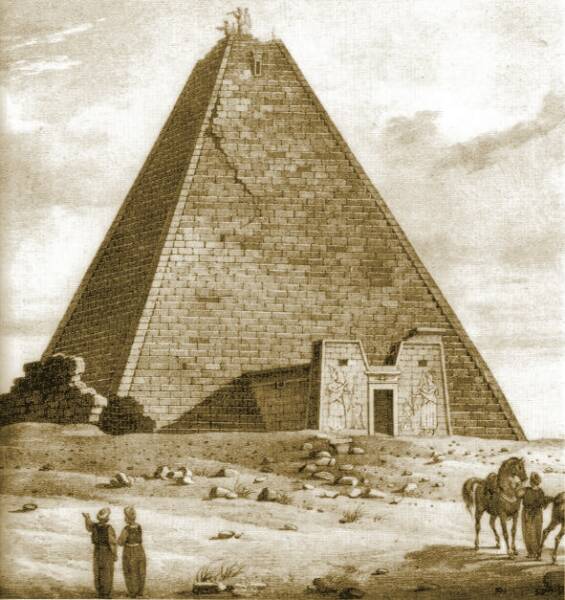Wad Ban Naqa on:
[Wikipedia]
[Google]
[Amazon]
 Wad ben Naga (also Wad Ban Naqa or Wad Naga) is the name of an ancient town of the Kushitic Kingdom of
Wad ben Naga (also Wad Ban Naqa or Wad Naga) is the name of an ancient town of the Kushitic Kingdom of
 The place is so far little explored. The earliest known building on the site is a very large, two-story brick palace built by Queen Amanishakheto (first century AD) whose large pyramid in the royal cemetery at Meroe (BEG N 6) contained a hoard of gold jewellery found in the early 19th century by the Italian treasure hunter, Giuseppe Ferlini (NB: several references to this site erroneously identify the pyramid as having been built at Wad ben Naga).Wildung (1997), p. 256
South of the palace is a circular building of unknown function, whose walls are still up to 5 m high. There was a temple of
The place is so far little explored. The earliest known building on the site is a very large, two-story brick palace built by Queen Amanishakheto (first century AD) whose large pyramid in the royal cemetery at Meroe (BEG N 6) contained a hoard of gold jewellery found in the early 19th century by the Italian treasure hunter, Giuseppe Ferlini (NB: several references to this site erroneously identify the pyramid as having been built at Wad ben Naga).Wildung (1997), p. 256
South of the palace is a circular building of unknown function, whose walls are still up to 5 m high. There was a temple of
 Wad ben Naga (also Wad Ban Naqa or Wad Naga) is the name of an ancient town of the Kushitic Kingdom of
Wad ben Naga (also Wad Ban Naqa or Wad Naga) is the name of an ancient town of the Kushitic Kingdom of Meroë
Meroë (; also spelled ''Meroe''; Meroitic: ; and ; ) was an ancient city on the east bank of the Nile about 6 km north-east of the Kabushiya station near Shendi, Sudan, approximately 200 km north-east of Khartoum. Near the site is ...
in present-day Sudan. The village lies on the eastern bank of the Nile
The Nile (also known as the Nile River or River Nile) is a major north-flowing river in northeastern Africa. It flows into the Mediterranean Sea. The Nile is the longest river in Africa. It has historically been considered the List of river sy ...
, about 80 kilometers upstream of Meroë
Meroë (; also spelled ''Meroe''; Meroitic: ; and ; ) was an ancient city on the east bank of the Nile about 6 km north-east of the Kabushiya station near Shendi, Sudan, approximately 200 km north-east of Khartoum. Near the site is ...
and about 40 km southwest of Shendi
Shendi or Shandi () is a small city in northern Sudan, situated on the southeastern bank of the Nile River 150 km northeast of Khartoum. Shandi is also about 45 km southwest of the ancient city of Meroë. Located in the River Nile s ...
.
History
 The place is so far little explored. The earliest known building on the site is a very large, two-story brick palace built by Queen Amanishakheto (first century AD) whose large pyramid in the royal cemetery at Meroe (BEG N 6) contained a hoard of gold jewellery found in the early 19th century by the Italian treasure hunter, Giuseppe Ferlini (NB: several references to this site erroneously identify the pyramid as having been built at Wad ben Naga).Wildung (1997), p. 256
South of the palace is a circular building of unknown function, whose walls are still up to 5 m high. There was a temple of
The place is so far little explored. The earliest known building on the site is a very large, two-story brick palace built by Queen Amanishakheto (first century AD) whose large pyramid in the royal cemetery at Meroe (BEG N 6) contained a hoard of gold jewellery found in the early 19th century by the Italian treasure hunter, Giuseppe Ferlini (NB: several references to this site erroneously identify the pyramid as having been built at Wad ben Naga).Wildung (1997), p. 256
South of the palace is a circular building of unknown function, whose walls are still up to 5 m high. There was a temple of Isis
Isis was a major goddess in ancient Egyptian religion whose worship spread throughout the Greco-Roman world. Isis was first mentioned in the Old Kingdom () as one of the main characters of the Osiris myth, in which she resurrects her sla ...
that has now been destroyed. Nearby was small temple with columns with the god Bes carved on them that might have functioned as a divine birth house (mammisi A mammisi (mamisi) is an ancient Egyptian small chapel attached to a larger temple (usually in front of the pylons Rachet, Guy (1994). ''Dizionario della civiltà egizia''. Rome: Gremese Editore. . p. 186.), built from the Late Period, and associa ...
). It was probably built by Natakamani and Amanitore (first century AD). There are the remains of several other unexplored temples at the site in addition to the one dedicated to Isis. New excavations at the site began in 2009 under the direction of the National Museum of the Czech Republic.
Notes and references
Bibliography
* *Wenig, Steffen : ''Die meroitische Königin Amanitore. Barkenuntersatz aus Wad Ban Naqa (Sudan), um 20 u.Z., Nr. 7261''. Neue Museumskunde 20 (2) (1977), S. 82 *''The temple of Apedemak in Naqua''. In S. 226f. {{DEFAULTSORT:Wad Ban Naqa Archaeological sites in Sudan Former populated places in Sudan Kingdom of Kush